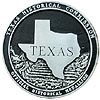| |
|
|
The Chihuahua Trail and Escondido Water Hole |
|
 |
|
Fort Lancaster State Historic Park, Ozona,
TX,
USA
Latitude & Longitude:
30° 39' 53.08968999996",
-101° 41' 41.7096099996"
|
| |
| |
|
Texas State
Historical Marker |
The Chihuahua Trail was opened by segments, but was not called by this name until the 19th century. A small part of the route, along the nearby Pecos River, was followed by the Spaniard Gaspar Castano de Sosa in 1590, during an expedition to New Mexico. By 1850, the trail was finally extended to connect the city of Chihuahua and the Texas Gulf Coast, by way of San Antonio. Gold seekers going to California found it practical because it touched at all known water holes in this rugged terrain. Heaviest use of the trail came during the mid-1870s, when freighters transported tons of silver and copper from the state of Chihuahua for shipment to the eastern U.S. One of the landmarks along the Chihuahua Trail in this part of western Texas was Escondido (Hidden) water hole, seven miles southeast of Fort Lancaster. A small, deep well in the side of a rugged canyon, this water source was very hard to find, but saved the lives of many travelers. However, it is flanked by rock cairns marking the graves of some who died near the water hole of accidents or disease.
This page last updated: 7/15/2008 |
The Chihuahua Trail and Escondido Water Hole Historical Marker Location Map, Ozona, Texas
|
|
|
|


